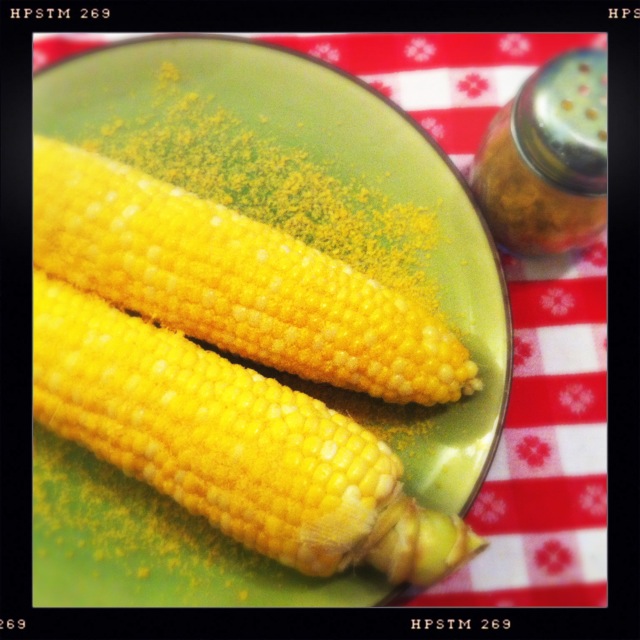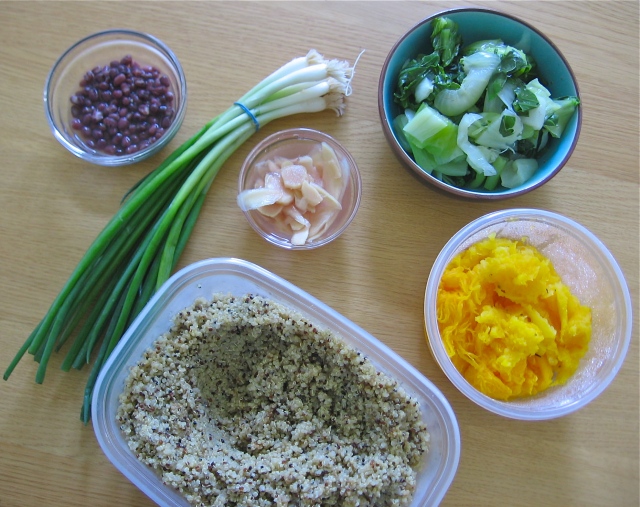So I had this eggplant. One medium-sized eggplant. And these zucchini, a whole bunch of them. And I wasn’t cooking them, and every day I’d poke them to see if they had developed the dreaded soft spots that those veggies get shortly before they turn into produce bags full of mush and slime. (Sorry, that’s a pretty gross way to start a food post.) Eggplant I’d normally make into baba ganoush, but if I’m going to wash the food processor I want to be making more than a spoonful; my usual recipe calls for three eggplants and only one had come in my box. Zucchini I’ve been roasting all summer, and it’s been excellent and easy, but I was starting to get a little bored.

So I went online to see what you could make with eggplant and zucchini. And mushrooms. I had this paper bag of mushrooms that I was also anxious to make use of before they left the edible zone. And the internet told me… ratatouille.
Ah, ratatouille. Years of choking you down at Mediterranean restaurants where you were the only vegetarian option on the menu. And these were the eggplant-hating years, even. I look at ratatouille the way soldiers in the field probably look at their MREs. Pure sustenance, nothing more.
Here are the problems I have with ratatouille: 1) It’s bland. It’s basically just a bunch of vegetables, cooked for a long time. Back in Provence in the 19th century or whenever it was invented, I bet that tasted amazing. But modern vegetables just don’t pack that kind of flavor wallop anymore, especially not tomatoes. 2) It’s usually served over couscous or, occasionally, rice. Because it’s bland, it doesn’t sauce up the grain, rather the grain pulls it even further into tastelessness. 3) The eggplant is ALWAYS undercooked, and therefore spongy, bitter, and unpalatable. Undercooked eggplant is the reason I hated eggplant. Now that I understand this I mostly only eat eggplant in three culinary situations: at home, where I control the cook time; in Chinese food, where they fry the heck out of tiny tender eggplants; in Indian food, where they cook the eggplant so long it’s barely recognizable as such by the end (mmm baingan bharta!).
But that got me to thinking. Here I was with eggplant, zucchini, tomato, onion, and mushrooms (I wouldn’t have thought of mushrooms in ratatouille ’til I came across a yummy-looking variant online). I’ve loved eggplant now in many forms when I’ve cooked it at home (click the eggplant tag at the end of this post to see) so who’s to say that being the author of the experience couldn’t transform ratatouille the same way?
Making the ratatouille took a long time because the each of the vegetables was first cooked separately so it could brown rather than steam. I believe the extra time is worthwhile in this case since that’s the very process that is going to transform your vegetables from bland, stewed mush to something more transcendent. It’s also important to me to make the distinction with recipes between difficult and time-consuming. This recipe is incredibly easy, just throw on an apron, turn on an audiobook, and chop and sauté and simmer your way to ratatouille bliss in a few hours.
And bliss it was indeed. This ratatouille was delicious. Deep rich caramelized flavors and a heartbreaking melting texture. I ate it for three meals straight and then I put the last remaining bit into tacos for a some fusion fun. I could go either way on the mushrooms – if I had them on hand I would include them again, but I wouldn’t go out of my way to get them for this recipe, which I think would be excellent without them as well.
I’m linking this recipe up to the weekly What’s In the Box linkup hosted by CSA blogger In Her Chucks. I love contributing my weekly CSA box-contents post to the linkup, but I also love when people post recipes they’ve made using their CSA veggies, so I thought I’d try out doing the same. Do check out the links – there are some seriously yummy things being made out there.
Non-Disgusting, Totally Not Bland Ratatouille (vegan, gluten-free eggplant, tomato, zucchini, onion, mushroom stew)
This is a lightly adapted version of a recipe from The Kitchn, which is definitely worth checking out since it’s a real recipe from a genuine Frenchman, as opposed to my perhaps inauthentic – but delicious! – version. I originally made half a recipe because I only had one eggplant, and it worked out fine, but if I was planning on sharing this yumminess with anyone else I would make a whole recipe’s worth.
2 eggplants
2 yellow onions
6-8 zucchini
1 pound cremini mushrooms
4 large tomatoes
1 1/2 – 2 tablespoons olive oil
3-4 cloves garlic
1 bay leaf
1 T. herbes de Provence, or more to taste
Red wine suitable for cooking, about 1 cup
Chopped fresh parsley (optional)
Salt and pepper
Begin by peeling the eggplants and chopping them into bite-sized cubes. Put them in a strainer set over a bowl (or in the sink) and toss with a tablespoon of salt. Let the eggplant sit while you prepare the rest of the ingredients.
Dice the onions. Warm a teaspoon of olive oil in a large (at least 5 1/2 quart) Dutch oven or pot over medium-high heat. Add the onions and a generous pinch of salt. Sauté until the onions have softened and are just beginning to brown, about 10 minutes.
While the onions are cooking, you can cut up the rest of your vegetables. Keep them separate because you’ll be cooking in batches. chop the zucchini and tomato into bite-sized pieces, slice the mushrooms, and mince (or press) the garlic.
When they have softened and begun to brown, transfer the onions to a large bowl.
At this point The Kitchn offers some helpful advice which I followed liberally, using much red wine: During cooking, a brown glaze will gradually build on the bottom of the pan. If it looks like this glaze is beginning to turn black and burn, turn down the heat to medium. You can also dissolve the glaze between batches by pouring 1/4 cup of water or wine into the pan and scraping up the glaze. Pour the deglazing liquid into the bowl with the vegetables.
So after you move the onions, go ahead and deglaze with 1/4 cup of red wine and then pour that off into the bowl with the onions.
Add another teaspoon of oil to the pot and sauté the zucchini with a generous pinch of salt until the zucchini has softened and is beginning to brown, about 5 minutes. Transfer the zucchini to the bowl with the onions. Deglaze!
Add another teaspoon of oil to the pot and sauté the mushrooms with a generous pinch of salt until they have softened and released their juices, about 10 minutes. Put them in your big veggie bowl. You know the drill – it’s probably time to deglaze!
While the mushrooms are cooking, rinse the eggplant under running water and squeeze the cubes gently with your hands to remove as much moisture as possible.
Warm two teaspoons of oil in the pan and sauté the eggplant until it has softened and has begun to turn translucent, about 10-15 minutes. Don’t skimp on time here. A cube of eggplant should taste edible – maybe not scrumptious, but cooked enough to be edible – before you transfer the eggplant to the bowl with the other vegetables. (You’re about to add the tomatoes, which are acidic, like wine, so they will take care of the deglazing on this step.)
Warm another teaspoon of olive oil in the pan and sauté the garlic until it is fragrant and just starting to turn golden, which will only take a few seconds or a minute at most. Add the tomatoes, bay leaf, and herbes de Provence. As the tomato juices begin to bubble, scrape up the brown glaze on the bottom of the pan.
Add all of the vegetables back into the pan and stir until everything is evenly mixed. Bring the stew to a simmer, then turn down the heat to low. Stirring occasionally, simmer for at least 30 minutes or up to 1 1/2 hours. Shorter cooking time will leave the vegetables in larger, more distinct pieces; longer cooking times will break the vegetables down into a silky stew.
Remove the bay leaf. Stir in some chopped parsley if you like, or sprinkle some over each bowl when you serve it. Enjoy ratatouille alone, as a stew – not as a topping for something else.
The Kitchn says: Leftovers can be refrigerated for a week or frozen for up to three months. Ratatouille is often better the second day, and it can be eaten cold, room temperature, or warmed.




















